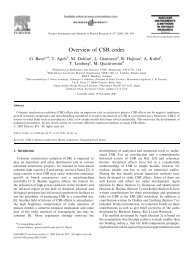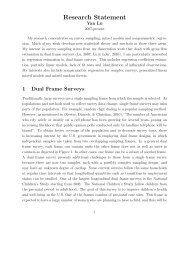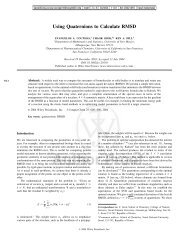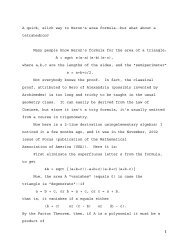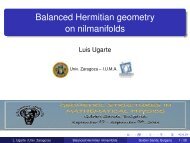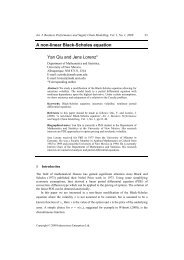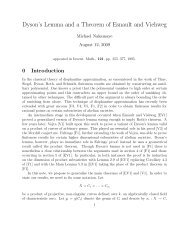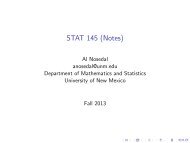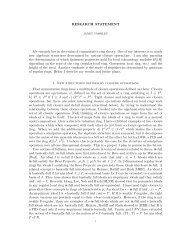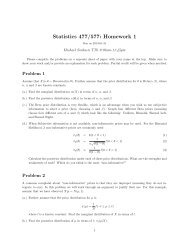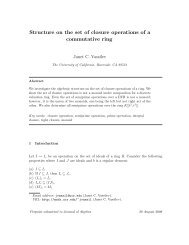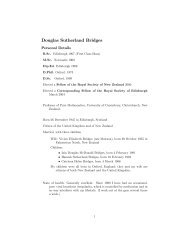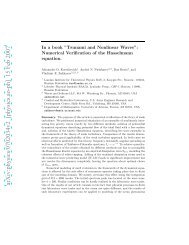OEO Office of Equal Opportunity - Department of Mathematics and ...
OEO Office of Equal Opportunity - Department of Mathematics and ...
OEO Office of Equal Opportunity - Department of Mathematics and ...
Create successful ePaper yourself
Turn your PDF publications into a flip-book with our unique Google optimized e-Paper software.
218 ARTS AND SCIENCES<br />
320./520. History <strong>of</strong> Women from Ancient Times to the<br />
Enlightenment. (3) Slaughter<br />
(Also <strong>of</strong>fered as WMST 320.) Study <strong>of</strong> sex roles in primitive<br />
societies, classical views <strong>of</strong> women, the Judeo-Christian<br />
treatment <strong>of</strong> women, medieval social roles <strong>and</strong> the changes<br />
that came with the Renaissance <strong>and</strong> Reformation. Attention<br />
will be paid to the role <strong>of</strong> women in the family <strong>and</strong> to their<br />
economic function as well as to the less common activities <strong>of</strong><br />
saint, witch <strong>and</strong> revolutionary.<br />
328./528. History <strong>of</strong> Science From Antiquity to the<br />
Scientific Revolution. (3) Moy<br />
A history <strong>of</strong> western science from ancient Mesopotamia<br />
through the “Scientific Revolution.”<br />
411./611. History <strong>of</strong> Engl<strong>and</strong>, 1066–1660. (3) Rubenstein<br />
Survey <strong>of</strong> medieval foundations, Tudor era <strong>and</strong> 17th-century<br />
social <strong>and</strong> political revolutions.<br />
IV. Modern Europe<br />
300./500. Studies in History. (1-3, no limit) ∆<br />
Will vary from instructor to instructor, but will be an in-depth<br />
analysis <strong>of</strong> specific historical problems. For course content,<br />
consult Schedule <strong>of</strong> Classes.<br />
310./510. Modern Europe, 1815–1890. (3)<br />
This course examines social, political <strong>and</strong> economic issues<br />
that shaped European society in the 19th century, including<br />
revolutions, imperial expansion, the emergence <strong>of</strong> class society,<br />
transformations in urban <strong>and</strong> rural environments, cultural<br />
identity <strong>and</strong> nationalism.<br />
311./511. World War I, 1914–1918. (3) Bokovoy<br />
A social, cultural, political, diplomatic <strong>and</strong> military history <strong>of</strong><br />
World War I.<br />
312./512. Modern Europe, 1890–1939. (3) Bokovoy,<br />
Schibeci<br />
The origins <strong>of</strong> World War I, World War II <strong>and</strong> the search for<br />
peace.<br />
313./513. Europe since 1939. (3) Bokovoy, Slaughter<br />
Study <strong>of</strong> the transformation <strong>of</strong> Europe after World War II as<br />
experienced on the political, economic, social <strong>and</strong> cultural<br />
levels.<br />
316./516. Russia in the Era <strong>of</strong> Reform <strong>and</strong> Revolution,<br />
1855–1924. (3) Robbins<br />
From the “Great Reforms” to the death <strong>of</strong> Lenin. Surveys the<br />
vast political, social <strong>and</strong> cultural changes which produced <strong>and</strong><br />
accompanied the Russian revolution.<br />
317./517. Stalinist <strong>and</strong> Post-Stalinist Russia, 1924 to<br />
Present. (3) Robbins<br />
Surveys the attempt to construct a communist society in<br />
Russia <strong>and</strong> the ultimate collapse <strong>of</strong> this tragic experiment.<br />
Briefly treats post-soviet developments. Emphasis on political,<br />
social <strong>and</strong> cultural change.<br />
319./519. Spain <strong>and</strong> Portugal since 1700. (3) Sanabria<br />
Survey <strong>of</strong> Spanish <strong>and</strong> Portuguese history since the war <strong>of</strong><br />
Spanish Succession through Spain <strong>and</strong> Portugal’s successful<br />
democratic transitions, with special emphasis on the second<br />
Spanish Republic <strong>and</strong> Civil War.<br />
321./521. Women in the Modern World. (3) Hutchinson,<br />
Scharff, Slaughter<br />
(Also <strong>of</strong>fered as WMST 316.) Study <strong>of</strong> western women<br />
from pre-industrial to contemporary society which will focus<br />
on Victorianism, familial roles, changes in work patterns,<br />
feminist movements <strong>and</strong> female participation in fascist <strong>and</strong><br />
revolutionary politics.<br />
329./529. History <strong>of</strong> Science Since the Enlightenment.<br />
(3) Moy<br />
A history <strong>of</strong> western science from the Enlightenment to the<br />
20th century.<br />
351./551. History <strong>of</strong> Sport. (3) Sanabria<br />
This course <strong>of</strong>fers an interdisciplinary exploration <strong>of</strong> the history<br />
<strong>of</strong> sport <strong>and</strong> the relationship between sport <strong>and</strong> societies<br />
in Western Europe, the United States <strong>and</strong> their colonies from<br />
Antiquity through modern times.<br />
414./614. Twentieth Century Spanish Culture. (3) Sanabria<br />
A historical approach to Spanish culture since the Spanish/<br />
American War (1898), focusing on regionalism, the commercialization<br />
<strong>of</strong> sport <strong>and</strong> leisure, the construction <strong>of</strong> gender<br />
roles <strong>and</strong> Spain’s entry into the European Community.<br />
415./615. European Diplomatic History. (3) Spidle<br />
Since 1815.<br />
416./616. History <strong>of</strong> Medicine to 1850. (3) Spidle<br />
A survey <strong>of</strong> western medicine’s development to mid-19th<br />
century, aimed at the nonspecialist. Includes the impact <strong>of</strong><br />
health factors in general historical development.<br />
417./617. History <strong>of</strong> Modern Medicine. (3) Spidle<br />
Survey <strong>of</strong> western medicine since mid-19th century, aimed<br />
at the nonspecialist. Includes the impact <strong>of</strong> health factors in<br />
general historical development.<br />
418./618. City Life. (3)<br />
(Also <strong>of</strong>fered as SOC 338.) A study <strong>of</strong> the development <strong>of</strong><br />
urban spaces <strong>and</strong> urban lives from the 17th century, which<br />
considers the impact <strong>of</strong> political <strong>and</strong> cultural changes upon<br />
physical spaces <strong>and</strong> their impact upon modern lives.<br />
419./619. Formation <strong>of</strong> Modern European Culture. (3)<br />
Via a broad variety <strong>of</strong> media arts, theories <strong>and</strong> documents,<br />
this course introduces students to people <strong>and</strong> events that<br />
have contributed to changing definitions <strong>of</strong> modern European<br />
cultural identity between the 17th <strong>and</strong> 20th centuries.<br />
420./620. Modern France since 1815. (3) Sanabria<br />
A survey <strong>of</strong> French history from the Bourbon Restoration<br />
through modern times. Particular attention given to the Third<br />
Republic, the French colonial empire, French fascism <strong>and</strong><br />
Vichy France, <strong>and</strong> France’s role in the modern world.<br />
421./621. Britain 1660 to the Present. (3)<br />
Surveys British society <strong>and</strong> culture from the restoration to<br />
the monarchy <strong>and</strong> emphasizes Britain’s influence on world<br />
politics <strong>and</strong> culture.<br />
422./622. Modern European Imperialism. (3)<br />
This course examines the expansion <strong>of</strong> European imperialism<br />
since the 17th century, from trading companies to cultural<br />
imperialism.<br />
423./623. Germany, 1871 to 1971. (3) Spidle<br />
Bismarck to Br<strong>and</strong>t, a survey <strong>of</strong> German history from unification<br />
to contemporary times, with special emphasis on Weimar<br />
<strong>and</strong> Hitlerian Germany.<br />
424./624. Modern Eastern Europe. (3) Bokovoy<br />
The study <strong>of</strong> the “other” Europe, examining Eastern Europe<br />
during WWI, the interwar years, WWII <strong>and</strong> the communist<br />
<strong>and</strong> post-communist eras.<br />
425./625. Europe <strong>and</strong> the Balkans. (3) Bokovoy<br />
This course explores the Balkan peninsula not only as<br />
Europe’s most diverse <strong>and</strong> complex cultural crossroad <strong>and</strong><br />
frontier, but as an “imagined” political <strong>and</strong> cultural other.<br />
426./626. History <strong>of</strong> the Holocaust. (3) Pugach<br />
(Also <strong>of</strong>fered as RELG 426.) An examination <strong>of</strong> the motives,<br />
methods <strong>and</strong> execution <strong>of</strong> the destruction <strong>of</strong> the Jews by Nazi<br />
Germany <strong>and</strong> the responses <strong>of</strong> Jews, Western Powers, the<br />
Churches <strong>and</strong> Righteous Gentiles in the context <strong>of</strong> Jewish<br />
<strong>and</strong> world history.<br />
427./627. History <strong>of</strong> Sexuality. (3) Slaughter<br />
(Also <strong>of</strong>fered as WMST 427.) Study <strong>of</strong> sexual behavior,<br />
politics <strong>and</strong> ideology in Western Society from the pre-modern<br />
world to the contemporary era. Background in History <strong>of</strong><br />
Women Studies is suggested.<br />
UNM CATALOG 2006–2007 Symbols, page 611.



